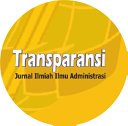Kebijakan Pengukuran Kedalaman Partnering untuk Meningkatkan Kinerja Proyek Konstruksi
DOI:
https://doi.org/10.31334/transparansi.v7i2.4276Abstract
Partnering dalam Industri konstruksi diperlukan untuk memperdalam interaksi dan memperbaiki komunikasi dari setiap stakeholder dalam proyek. Komunikasi yang mendalam akan menimbulkan inovasi pada pelaksanaan proyek, sehingga kinerja proyek dapat tercapai. Penelitian ini bertujuan untuk mengukur efektifitas dari pengembangan kebijakan pengukuran kedalaman partnering dalam proyek, melalui metode kualitatif dan kuantitatif penelitian ini akan mengambil studi kasus sebanyak 6 (enam) lokasi proyek Design & Build selanjutnya dilakukan Focus Group Discussion (FGD) pakar untuk memvalidasi hasil pengukuran yang dilakukan. Hasil dari penelitian ini adalah diperlukan pengembangan tools and technique untuk mengukur kedalaman partnering dalam proyek Konstruksi sehingga akan mendorong peningkatan kinerja proyek. Penelitian ini akan memberikan manfaat bagi pelaku proyek konstruksi, akademisi dan siapapun yang berfokus pada peningkatan kinerja proyek melalui partnering.References
Alwi, Mohamed, & Sherif, and K. Hampson, “Waste in the Indonesian Construction Projects,†2002. [Online]. Available: https://eprints.qut.edu.au/secure/00004163/01/CIB_W107_-
Lauren Pinch, “Lean Eliminating the Waste Construction,†Construction Executive, pp. 34–37, 2005.
S. O. Ajayi, “DESIGN, PROCUREMENT AND CONSTRUCTION STRATEGIES FOR MINIMIZING WASTE IN CONSTRUCTION PROJECTS,†2016.
Elizar, Suripin, and M. A. Wibowo, “Model of Construction Waste Management Using AMOS-SEM for Indonesian Infrastructure Projects,†in MATEC Web of Conferences, EDP Sciences, Dec. 2017. doi: 10.1051/matecconf/201713805005.
G. J. Treloar, H. Gupta, P. E. d. Love, and B. Nguyen, “An analysis of factors influencing waste minimisation and use of recycled materials for the construction of residential buildings,†Management of Environmental Quality: An International Journal, vol. 14, no. 1. pp. 134–145, Mar. 01, 2003. doi: 10.1108/14777830310460432.
I. M. Katar, “Enhancing the Project Delivery Quality; Lean Construction Concepts of Design-Build & Design-Bid-Build Methods,†International Journal of Management, vol. 10, no. 6, pp. 324–337, 2019, doi: DOI: 10.34218/IJM.10.6.2019.031.
E. W. M. Lam, A. P. C. Chan, and D. W. M. Chan, “Benchmarking design-build procurement systems in construction,†Benchmarking, vol. 11, no. 3. Emerald Group Publishing Ltd., pp. 287–302, 2004. doi: 10.1108/14635770410538763.
M. El Asmar, M. Asce, A. S. Hanna, F. Asce, and W.-Y. Loh, “Quantifying Performance for the Integrated Project Delivery System as Compared to Established Delivery Systems,†2013, doi: doi:10.1061/(asce)co.1943-7862.0000744.
B. Xia, Q. Chen, Y. Xu, M. Li, and X. Jin, “Design-Build Contractor Selection for Public Sustainable Buildings,†Journal of Management in Engineering, vol. 31, no. 5, Sep. 2015, doi: 10.1061/(asce)me.1943-5479.0000295.
E. Sari, A. Irawan, and M. Wibowo, “Design Partnering Framework to Reduce Financial Risk in Construction Projects,†European Alliance for Innovation n.o., Sep. 2022. doi: 10.4108/eai.31-3-2022.2320722.
E. Murtiana Sari, A. Purna Irawan, and M. Agung Wibowo, “Role of Technical Education in Partnering Construction Project: A Geographical Study on Indonesia,†Review of International Geographical Education (RIGEO), vol. 11, no. 1, pp. 636–644, 2021, doi: 10.48047/rigeo.11.1.49.
E. M. Sari, A. P. Irawan, M. A. Wibowo, J. P. Siregar, and A. K. A. Praja, “Project Delivery Systems: The Partnering Concept in Integrated and Non-Integrated Construction Projects,†Sustainability (Switzerland), vol. 15, no. 1, 2023, doi: 10.3390/su15010086.
E. M. Sari et al., “Challenge and Awareness for Implemented Integrated Project Delivery (IPD) in Indonesian Projects,†Buildings, vol. 13, no. 1, 2023, doi: 10.3390/buildings13010262.
A. Thohirin, M. A. Wibowo, D. Mohamad, E. M. Sari, R. Z. Tamin, and H. Sulistio, “Tools and Techniques for Improving Maturity Partnering in Indonesian Construction Projects,†Buildings, vol. 14, no. 6, p. 1494, May 2024, doi: 10.3390/buildings14061494.
M. Pinto Nunez, C. Lopez Del Puerto, and H. D. Jeong, “Development of a Partnering Maturity Assessment Tool for Transportation Agencies,†Journal of Legal Affairs and Dispute Resolution in Engineering and Construction, vol. 10, no. 4, Nov. 2018, doi: 10.1061/(asce)la.1943-4170.0000272.
L. E. Gadde and A. Dubois, “Partnering in the construction industry-Problems and opportunities,†Journal of Purchasing and Supply Management, vol. 16, no. 4, pp. 254–263, Dec. 2010, doi: 10.1016/j.pursup.2010.09.002.
E. Murtiana Sari, A. Purna Irawan, M. Agung Wibowo, and O. Sinaga, “Applying Soft Systems Methodology To Identified Factors Of Partnerships Model In Construction Project-Palarch’s,†2020.
W. T. Chen, H. C. Merrett, S. T. Lu, and L. Mortis, “Analysis of key failure factors in construction partnering-A case study of Taiwan,†Sustainability (Switzerland), vol. 11, no. 14, 2019, doi: 10.3390/su11143994.
J. Nyström, “Partnering; definition, theory and the procurement phase,†2005.
T. O. Malvik and A. Engebø, “Experiences with Partnering: A Case Study on the Development Phase,†Procedia Comput Sci, vol. 196, pp. 1044–1052, 2022, doi: 10.1016/j.procs.2021.12.108.
P. Lahdenperä, “Making sense of the multi-party contractual arrangements of project partnering, project alliancing and integrated project delivery,†Construction Management and Economics, vol. 30, no. 1, pp. 57–79, Jan. 2012, doi: 10.1080/01446193.2011.648947.
T. G. Crane, J. P. Felder, P. J. Thompson, M. G. Thompson, S. R. Sanders, and A. Member, “PARTNERING MEASURES,†1997. doi: https://doi.org/10.1061/(ASCE)0742-597X(1999)15:2(37).
L. G. Crowley and M. A. Karim, “CONCEPTUAL MODEL OF PARTNERING,†1995. doi: http://dx.doi.org/10.1061/(ASCE)0742-597X(1995)11:5(33).
P. J. Thompson’, S. R. Sanders, and A. Member, “PARlNERING CONTINUUM,†1998.
H. W. Ashcraft and H. Bridgett, “IPD Teams: Creation, Organization and Management,†2011.
R. Leicht and C. Harty, “Influence of Multiparty IPD Contracts on Construction Innovation,†2017.
E. M. Sari et al., “Design bid build to integrated project delivery: Strategic formulation to increase partnering,†Journal of Infrastructure, Policy and Development, vol. 8, no. 1, Dec. 2023, doi: 10.24294/jipd.v8i1.2242.
D. Tran, K. R. Molenaar, and D. D. Gransberg, “Implementing best-value procurement for design-bid-build highway projects,†Transp Res Rec, vol. 2573, pp. 26–33, 2016, doi: 10.3141/2573-04.
“Lean Management vs Traditional Management.â€
A. M. Odeh and H. T. Battaineh, “Causes of construction delay: traditional contracts,†2002. [Online]. Available: www.elsevier.com/locate/ijproman
A. P. C. Chan, D. Scott, and E. W. M. Lam, “Framework of Success Criteria for DesignÕBuild Projects,†Management Engineering, vol. 18, no. 3, pp. 120–128, 2002, doi: 10.1061/ASCE0742-597X200218:3120.
M. El Asmar, M. Asce, A. S. Hanna, F. Asce, and W.-Y. Loh, “Quantifying Performance for the Integrated Project Delivery System as Compared to Established Delivery Systems,†2013, doi: 10.1061/(asce)co.1943-7862.0000744.
et al Abbas Ali Sahib, “The Relationship among Team Skills and Competencies,Construction Risk Managementand Supply Chain Performance with Moderating Effectof Government Laws Acts,and Policies:A Study from Iraq Construction Contractors,†2022.
H. Doloi, “Cost Overruns and Failure in Project Management: Understanding the Roles of Key Stakeholders in Construction Projects,†2013, doi: 10.1061/(ASCE)CO.1943-7862.
F. M. Halil, N. M. Nasir, A. S. Shukur, and H. Hashim, “A quantitative analysis study on the implementation of partnering in the design and build construction project,†in IOP Conference Series: Earth and Environmental Science, Institute of Physics Publishing, Mar. 2018. doi: 10.1088/1755-1315/117/1/012033.
H. Zahoor, A. P. C. Chan, R. Gao, and W. P. Utama, “The factors contributing to construction accidents in Pakistan: Their prioritization using the Delphi technique,†Engineering, Construction and Architectural Management, vol. 24, no. 3, pp. 463–485, 2017, doi: 10.1108/ECAM-01-2016-0027.
K. A. Alomari, J. A. Gambatese, and N. Tymvios, “Risk Perception Comparison among Construction Safety Professionals: Delphi Perspective,†J Constr Eng Manag, vol. 144, no. 12, Dec. 2018, doi: 10.1061/(asce)co.1943-7862.0001565.
M. Gunduz and H. A. Elsherbeny, “Operational Framework for Managing Construction-Contract Administration Practitioners’ Perspective through Modified Delphi Method,†J Constr Eng Manag, vol. 146, no. 3, Mar. 2020, doi: 10.1061/(asce)co.1943-7862.0001768.
E. E. Ameyaw, Y. Hu, M. Shan, A. P. C. Chan, and Y. Le, “Application of Delphi method in construction engineering and management research: A quantitative perspective,†Journal of Civil Engineering and Management, vol. 22, no. 8, pp. 991–1000, Nov. 2016, doi: 10.3846/13923730.2014.945953.
M. R. Hallowell and J. A. Gambatese, “Qualitative Research: Application of the Delphi Method to CEM Research,†Journal of Construction Engineering and Management , pp. 1–10, 2010, doi: 10.1061/ASCECO.1943-7862.0000137.
bo Xia and A. P. c. Chan, “Measuring complexity for building projects: A Delphi study,†Engineering, Construction and Architectural Management, vol. 19, no. 1, pp. 7–24, Jan. 2012, doi: 10.1108/09699981211192544.
H. A. Linstone and M. Turoff, “Appendix: Delphi Bibliography.â€
E. Kania, G. Åšladowski, E. Radziszewska-Zielina, B. Sroka, and B. Szewczyk, “Planning and monitoring communication between construction project participants,†Archives of Civil Engineering, vol. 67, no. 2, pp. 455–473, 2021, doi: 10.24425/ace.2021.137179.
E. Safapour, S. M. Asce, S. Kermanshachi, M. Asce, S. Kamalirad, and D. Tran, “Identifying Effective Project-Based Communication Indicators within Primary and Secondary Stakeholders in Construction Projects,†2019, doi: 10.1061/(ASCE).
D. Zimina, G. Ballard, and C. Pasquire, “Target value design: using collaboration and a lean approach to reduce construction cost,†Construction Management and Economics, vol. 30, no. 5, pp. 383–398, May 2012, doi: 10.1080/01446193.2012.676658.
T. Park, T. Kang, Y. Lee, and K. Seo, “Project Cost Estimation of National Road in Preliminary Feasibility Stage Using BIM/GIS Platform,†2014.
S. C. Kim, J. S. Yoon, O. K. Cheol, and J. H. Paek, “Feasibility Analysis Simulation Model for Managing Construction Risk Factors,†Journal of Asian Architecture and Building Engineering, vol. 4, no. 1, pp. 193–200, 2005, doi: 10.3130/jaabe.4.193.
T. Park, T. Kang, Y. Lee, and K. Seo, “Project Cost Estimation of National Road in Preliminary Feasibility Stage Using BIM/GIS Platform,†2014.
A. Bigwanto, N. Widayati, M. A. Wibowo, and E. M. Sari, “Lean Construction: A Sustainability Operation for Government Projects,†Sustainability, vol. 16, no. 8, p. 3386, Apr. 2024, doi: 10.3390/su16083386.
A. Fath et al., “Readiness for Implemented Sustainable Procurement in Indonesian Government Construction Readiness for Implemented Sustainable Procurement in Indonesian Government Construction Project,†2024, doi: 10.3390/buildings14051424.
K. Aboul-Ata, “Towards Effective Earned Value Technique in Construction Management,†International Journal of Civil Engineering and Technology (IJCIET), vol. 10, no. 12, pp. 384–394, 2019, [Online]. Available: http://iaeme.com/Home/journal/IJCIET384editor@iaeme.comhttp://iaeme.com/Home/issue/IJCIET?Volume=10&Issue=12http://iaeme.com
M. Calahorra-Jimenez, K. Molenaar, C. Torres-Machi, A. Chamorro, and L. F. Alarcón, “Structured Approach for Best-Value Evaluation Criteria: US Design–Build Highway Procurement,†Journal of Management in Engineering, vol. 36, no. 6, Nov. 2020, doi: 10.1061/(asce)me.1943-5479.0000857.
K. R. Molenaar and D. E. Johnson, “Engineering The Procurement Phase to Achieve Best Value Leadership and Management in Engineering,†2003. [Online]. Available: http://www.colorado.edu/
E. Hermanto, S. Soetomo, and M. Agung Wibowo, “Toward Partnership for Government Construction Project in Indonesia,†International Journal of Scientific and Research Publications (IJSRP), vol. 8, no. 10, Oct. 2018, doi: 10.29322/ijsrp.8.10.2018.p8286.
R. Ghassemi and Gerber-Becerik, “Transitioning to IPD: Potential Barriers & Lessons Learned,†2011. [Online]. Available: www.leanconstructionjournal.org
S. Glick and A. A. Guggemos, “IPD and BIM: Benefits and Opportunities for Regulatory Agencies Background of IPD and BIM.â€
Atkinson Roger, “atkinson iron triangle,†pp. 1–6, 1999.
C. Ahbab, “An Investigation on Time and Cost Overrun in Construction Projects,†2012.
A. A. G. A. Yana, H. A. Rusdhi, and M. A. Wibowo, “Analysis of factors affecting design changes in construction project with Partial Least Square (PLS),†in Procedia Engineering, Elsevier Ltd, 2015, pp. 40–45. doi: 10.1016/j.proeng.2015.11.007.
L. S. R. Daniel W. Halpin, “planning analysis and construction operation,†books, pp. 1–322, 2000.
D. J. Weeks and F. Leite, “Facility Defect and Cost Reduction by Incorporating Maintainability Knowledge Transfer Using Maintenance Management System Data,†Journal of Performance of Constructed Facilities, vol. 35, no. 2, Apr. 2021, doi: 10.1061/(asce)cf.1943-5509.0001569.
J. L. Fernandez-Solis et al., “Survey of Motivations, Benefits, and Implementation Challenges of Last Planner System Users,†J Constr Eng Manag, vol. 139, no. 4, pp. 354–360, Apr. 2013, doi: 10.1061/(asce)co.1943-7862.0000606.
D. Schrijvers et al., “A review of methods and data to determine raw material criticality,†Resources, Conservation and Recycling, vol. 155. Elsevier B.V., Apr. 01, 2020. doi: 10.1016/j.resconrec.2019.104617.
D. Besiktepe, M. E. Ozbek, and R. A. Atadero, “Identification of the criteria for building maintenance decisions in facility management: First step to developing a multi-criteria decision-making approach,†Buildings, vol. 10, no. 9, Sep. 2020, doi: 10.3390/BUILDINGS10090166.
Downloads
Published
Issue
Section
License

This work is licensed under a Creative Commons Attribution-ShareAlike 4.0 International License
Please find the rights and licenses in Transparansi : Jurnal Ilmiah Ilmu Administrasi By submitting the article/manuscript of the article, the author(s) agree with this policy. No specific document sign-off is required.
- License
The commercial use of the article will be governed by the Creative Commons Attribution license as currently displayed on Creative Commons Attribution-ShareAlike 4.0 International License.
2. Author(s)' Warranties
The author warrants that the article is original, written by stated author(s), has not been published before, contains no unlawful statements, does not infringe the rights of others, is subject to copyright that is vested exclusively in the author and free of any third party rights, and that any necessary written permissions to quote from other sources have been obtained by the author(s).
3. User Rights
Transparansi : Jurnal Ilmiah Ilmu Administrasi spirit is to disseminate articles published are as free as possible. Under the Creative Commons license, Transparansi : Jurnal Ilmiah Ilmu Administrasi permits users to copy, distribute, display, and perform the work for non-commercial purposes only. Users will also need to attribute authors and Transparansi : Jurnal Ilmiah Ilmu Administrasi on distributing works in the journal and other media of publications.
4. Co-Authorship
If the article was jointly prepared by more than one author, any authors submitting the manuscript warrants that he/she has been authorized by all co-authors to be agreed on this copyright and license notice (agreement) on their behalf, and agrees to inform his/her co-authors of the terms of this policy. Transparansi : Jurnal Ilmiah Ilmu Administrasi will not be held liable for anything that may arise due to the author(s) internal dispute. Transparansi : Jurnal Ilmiah Ilmu Administrasi will only communicate with the corresponding author.
5. Miscellaneous
Transparansi : Jurnal Ilmiah Ilmu Administrasi will publish the article (or have it published) in the journal if the article’s editorial process is successfully completed. Transparansi : Jurnal Ilmiah Ilmu Administrasi editors may modify the article to a style of punctuation, spelling, capitalization, referencing and usage that deems appropriate. The author acknowledges that the article may be published so that it will be publicly accessible and such access will be free of charge for the readers as mentioned in point 3.
Every accepted manuscript should be accompanied by "Copyright Transfer Agreement"prior to the article publication.











